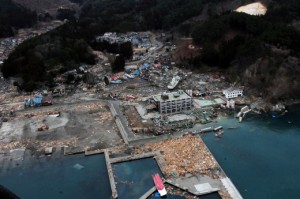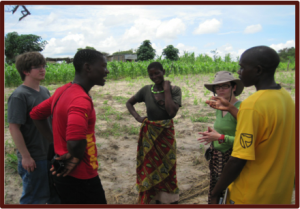The year 2017 saw overall losses of $US 330 billion. Historically, only 2011 with losses of $US 350 billion had higher losses, and that was the year of the Great East Japan Earthquake and tsunami, as well as the Thailand floods. It seems clear that disasters are becoming more common, and that losses continue to grow despite risk reduction efforts.
In March 2015, UN Secretary-General Ban Ki-moon warned “growing global inequality, increasing exposure to natural hazards, rapid urbanization and the overconsumption of energy and natural resources threaten to drive risk to dangerous and unpredictable levels with systemic global impacts.” According to the 2015 Global Assessment Report on Disaster Risk Reduction (GAR15), economic losses from disasters are now reaching an average of US$250 billion to US$300 billion annually.

Damage from the Great East Japan Tsunami in Otsuchi, Iwate, Japan, 15 March 2011. Source: wikimedia commons.
Meanwhile, worldwide economic difficulties prevent a proportionate increase in funding emergency actions after the occurrence of major hazards (disaster response). Several recent studies have demonstrated that investment before catastrophes reduce losses and save lives. In his speech at the opening ceremony of the 3rd UN World Conference on Disaster Risk Reduction, Ban Ki-moon recalled that “six billion dollars allocated each year can result in savings of up to US$360 billion by 2030”, asking for efforts to be broadened to all phases of disaster management and not solely on response. Former European Commissioner for Humanitarian Aid and Civil Protection Kristalina Georgieva has indicated that investing in prevention can be up to seven times less expensive and 40% less deadly than rebuilding and repairing damages after events. In the recent years, several major international organizations such as the World Bank, the United Nations Office for Disaster Reduction (UNISDR), and the European Commission have refocused their efforts on disaster risk reduction (DRR) and resilience to limit the devastating consequences of potential future crisis events.
With the same spirit, space agencies have initiated a series of actions to support DRM more efficiently, with a focus on DRR, by optimizing and better coordinating satellite Earth observations. While improvements to the International Charter or Sentinel Asia for example can offer enhanced post-crisis support, it’s critical that space agencies invest in disaster preparedness and prevention. It’s in this context that CEOS created the Working Group on Disasters (WGDisasters) at its 2013 Plenary meeting, following a preliminary study and prototyping phase initiated in 2012.
The overarching goals of the WGDisasters are to increase and strengthen satellite Earth observation contributions to the various Disaster Risk Management (DRM) phases and to inform politicians, decision-makers, and major stakeholders on the benefits of using satellite Earth Observations in each of those phases. To achieve these goals, CEOS Agencies have agreed to a series of objectives/actions that will improve the coordination of Earth Observations satellites, improve satellite Earth Observation data distribution, and foster the use of satellite data by DRM users. The Working Group has:
- Defined a global satellite observation strategy for DRM (including a detailed assessment of needs, gaps, and satellite Earth observation requirements and the development of a strategy);
- Ensured the appropriate inclusion of satellite Earth observations in the “Sendai Framework for Disaster Risk Reduction 2015-2030”;
- Supported DRM Outreach and Evaluation of DRM
- Developed and strengthened relationships with stakeholder and end-users through a series of concrete actions addressing single-hazard Pilots projects (currently floods, volcanoes and seismic hazards), multi-hazards projects such as the Recovery Observatory and the GEO Geohazard Supersites and Natural Laboratories (GSNL), and through CEOS capacity building activities for disaster managers.
The CEOS DRM initiative relies on several on-going activities conducted or supported either within the individual CEOS Agencies or within other CEOS entities. For instance, the CEOS Working Group on Information Systems & Services (WGISS) supported the WGDisasters DRM activities via its Global Earth Observation System of Systems (GEOSS) Architecture for the use of Satellites for Disasters and Risk Assessment (GA.4.Disasters) project and by forging a collaborative IT infrastructure in the context of the Recovery Observatory. Training courses have been organized by the Working Group on Capacity Building and Data Democracy (WGCapD).
As CEOS Agencies demonstrate their capacity to deliver satellite Earth observation data for improved DRM, there is growing pressure to ensure these observations are included in major initiatives. CEOS was present at the Sendai Conference (WCDRR, 14-18 March 2015, Sendai, Japan) to articulate its contribution to the “Sendai Framework for Disaster Risk Reduction 2015-2030”.
The Disaster Risk Management (DRM) Observation Strategy

NASA staff discuss flooding with villagers in Namibia. Through the CEOS Flood Pilot, satellite imagery supports early warning for evacuations during the flood season. Source: NASA.
The CEOS DRM Observation Strategy is a response to a collection of observation requirements from the user community to enable the delivery of three coordinated pilot studies to be implemented in 2014-2017 in three thematic areas.
A fourth pilot was launched in 2017. Each of these thematic pilots aimed to serve as a showcase for the international DRM community, in particular demonstrating a) the added value and uniqueness of increased CEOS coordination in this area; b) the benefits of closer ties to users and ease of access to data; and c) the potential for the increased roles of space agencies in DRM beyond the current Hyogo Framework for Action for the following 15-year period starting in 2015.
Following the successful completion of the pilots, two demonstrators were created to increase user uptake of satellite imagery in key application areas, and a third demonstrator is under definition.
Important Dates
- June 2020 – Group on Earth Observations (GEO) Symposium, Geneva, Switzerland
- November 2020 – Group on Earth Observations (GEO) Week, Port Elizabeth, South Africa
- November 2020 – World Bank GFDRR Understanding Risk Forum, Singapore